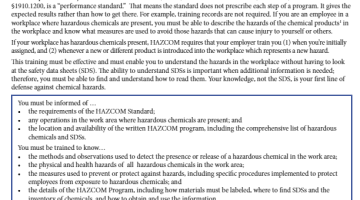The Occupational Safety and Health Administration (OSHA) Hazard Communication (HAZCOM) Standard, 29 CFR §1910.1200, is a “performance standard.” That means the standard does not prescribe each step of a program. It gives the expected results rather than how to get there. For example, training records are not required. If you are an employee in a workplace where hazardous chemicals are present, you must be able to describe the hazards of the chemical products1 in the workplace and know what measures are used to avoid those hazards that can cause injury to yourself or others.
If your workplace has hazardous chemicals present, HAZCOM requires that your employer train you (1) when you’re initially assigned, and (2) whenever a new or different product is introduced into the workplace which represents a new hazard.
This training must be effective and must enable you to understand the hazards in the workplace without having to look at the safety data sheets (SDS). The ability to understand SDSs is important when additional information is needed; therefore, you must be able to find and understand how to read them. Your knowledge, not the SDS, is your first line of defense against chemical hazards.
You must be informed of …
- the requirements of the HAZCOM Standard;
- any operations in the work area where hazardous chemicals are present; and
- the location and availability of the written HAZCOM program, including the comprehensive list of hazardous chemicals and SDSs.
You must be trained to know…
- the methods and observations used to detect the presence or release of a hazardous chemical in the work area;
- the physical and health hazards of all hazardous chemicals in the work area;
- the measures used to prevent or protect against hazards, including specific procedures implemented to protect employees from exposure to hazardous chemicals; and
- the details of the HAZCOM Program, including how materials must be labeled, where to find SDSs and the inventory of chemicals, and how to obtain and use the information.

